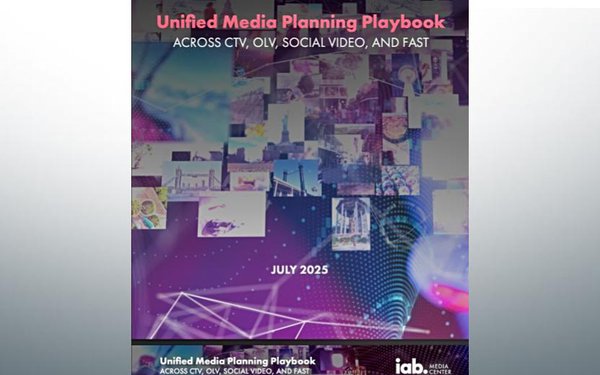
If you had asked me back in 1996 what trade association would emerge as the
dominant force across all media planning and buying, I probably would not have said the IAB.
That was the year it was launched, and back then its acronym stood for Internet Advertising Bureau.
It changed it to Interactive Advertising Bureau in 2001 to "more accurately reflect" its membership, because interactive digital media was already spreading its wings well beyond the conventional
internet.
Based on the past few years of expansion and diversification into all things digital, especially social, video, the NewFronts -- and just the other week, out-of-home -- I'm going to say it's time to reboot it as the UMAB, or "Unified
Media Advertising Bureau."
advertisement
advertisement
Also, it just released a new media-planning "playbook" covering CTV, online video, social video, and FAST (free ad-supported television services).
Never mind
that the aptly named "Unified Media Planning Playbook" doesn't include digital
display advertising, or so-called offline media (they still exist you know). It seems the UMAB -- er, I mean IAB -- is making a play for the whole media-planning enchilada.
Personally, I'm
tickled by an attempt to create a "unified" media-planning tome that does not include some of the major ad-supported media, or that we even need something called a Unified Media Planning Playbook,
because -- well, wasn't media-planning always supposed to unify all the media channels relevant to the agency or brand planning them?
That said, the 17-page playbook mentions the term
"unified" 52 times.
As someone who keeps an eye peeled against media planning hyperbole, I had to check to see how common the term Unified Media Planning is actually used, and whether it is
supposed to include non-digital media as part of its unification process. So I did what I always do.
First I searched MediaPost to see if, and how much, we have covered it.
Our
internal search engine yielded nine hits, including the ANA's Bill Duggan's recent Q&A with Newell CMO Melanie Huet, as well as a 2009
column by Tyler Willis utilizing the Enstein-esque metaphor about a "Unified Planning Theory." Apparently,
it's no longer theoretical.
The next thing I did was search Google for news coverage references to "unified media planning" and found 60 going back to a 2009 Ad Age article. In fact,
most of the news coverage about the unified phenomenon was attributed to Ad Age, including this week's story covering the IAB's new playbook, which it described as a "solution" the the modern
day "patchwork" of the media marketplace.
Lastly, I checked with an AI -- Google's Gemini, to be consistent -- and asked it to define the term "unified media planning" and when it first
emerged. You can read it's answer below, which describes it as an offshoot of an earlier planning framework -- Integrated Marketing Communications, or IMC -- and interestingly gives first use
cred to Tyler Willis' 2009 MediaPost column.
The Rise of Unified Media Planning: A Holistic Approach to a Fragmented WorldUnified media planning has emerged as a crucial strategic framework in modern marketing, representing a significant evolution from traditional and even integrated
approaches.This data-driven methodology aims to provide a holistic view of marketing efforts, enabling brands to optimize their budget, message, and
channel selection for maximum impact in an increasingly fragmented media landscape.
The conceptual seeds of unified media planning
were sown from the broader philosophy of Integrated Marketing Communications (IMC), which gained prominence in the 1980s. IMC challenged the siloed approach to marketing, advocating for
a consistent and synergistic brand message across all consumer touchpoints, from advertising and public relations to direct mail and sales promotions.
However, the true impetus for what we now call unified media planning arrived with the explosion of digital
media in the late 1990s and 2000s. The proliferation of websites, social media platforms, mobile devices, and streaming services created a complex and often disconnected customer journey. This
fragmentation posed a significant challenge to marketers seeking to understand the effectiveness of their campaigns and allocate resources efficiently.While a
precise "invention" date is difficult to pinpoint, the terminology and a more formalized concept of a unified approach began to gain traction in the late 2000s. A key moment can be traced to a 2009
article by Tyler Willis titled "Unified Media Theory,"which articulated the need to strategically combine paid and earned media to maximize campaign effectiveness in the digital
age. The transition from IMC to unified media planning was driven by several key factors:
Data and Analytics: The rise of advanced data analytics and marketing attribution models
allowed for a much deeper understanding of how different channels contribute to consumer behavior and conversions. This enabled a more precise and data-informed approach to media allocation than the
more message-focused IMC.
Technological Advancements: The development of sophisticated marketing technology
platforms, including data management platforms (DMPs), customer data platforms (CDPs), and programmatic advertising, provided the infrastructure needed to manage and execute complex, cross-channel
campaigns from a centralized hub.
Consumer Behavior: Modern consumers seamlessly move between various
online and offline channels.
Focus on ROI: In an increasingly competitive market, the pressure to
demonstrate a clear return on investment (ROI) for marketing spend has intensified.
In essence, while Integrated Marketing
Communications laid the foundational principle of a consistent brand message, unified media planning represents the operational and technological evolution of this idea. It moves beyond simple message
consistency to a more sophisticated, data-driven integration of strategy, execution, and measurement across the entire media ecosystem. This allows marketers to not only speak with one voice but also
to intelligently allocate resources and adapt their strategies in real-time based on a comprehensive understanding of what is truly driving results.